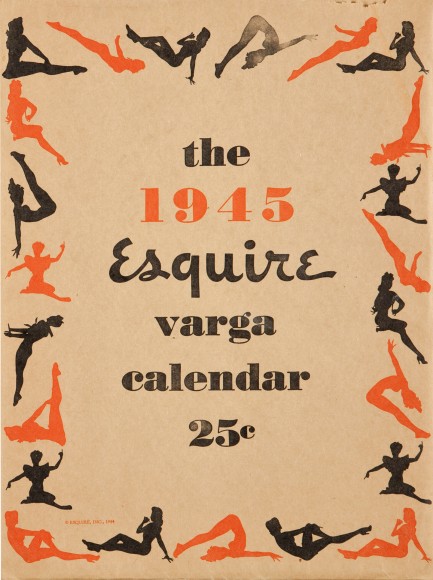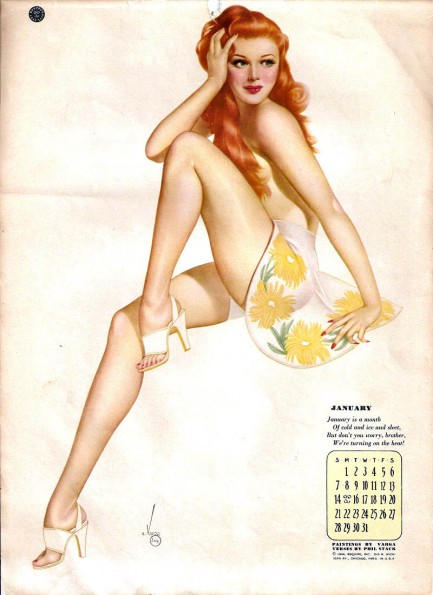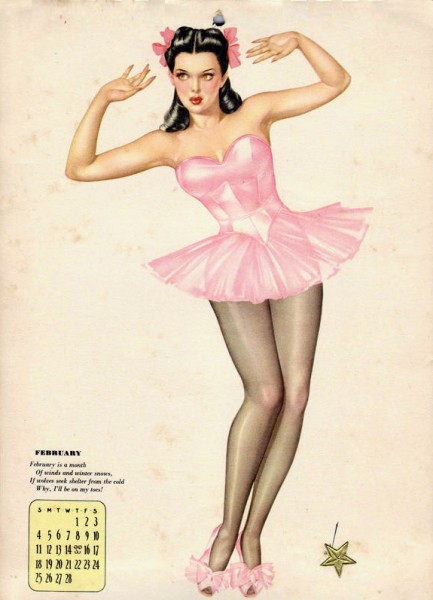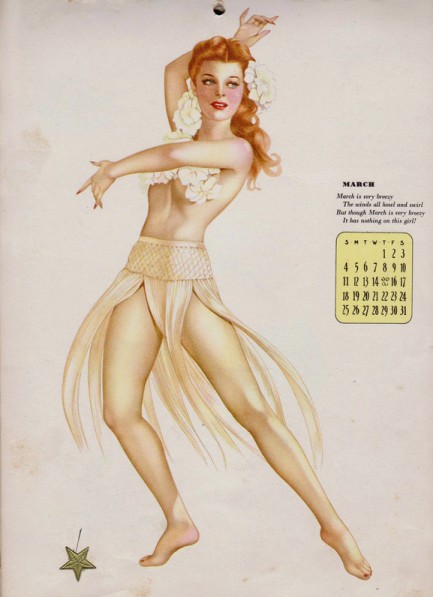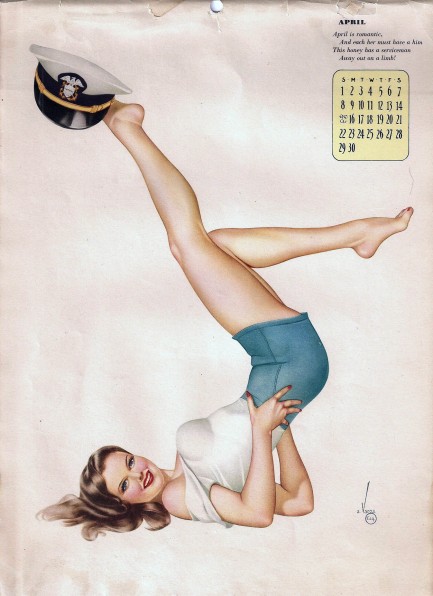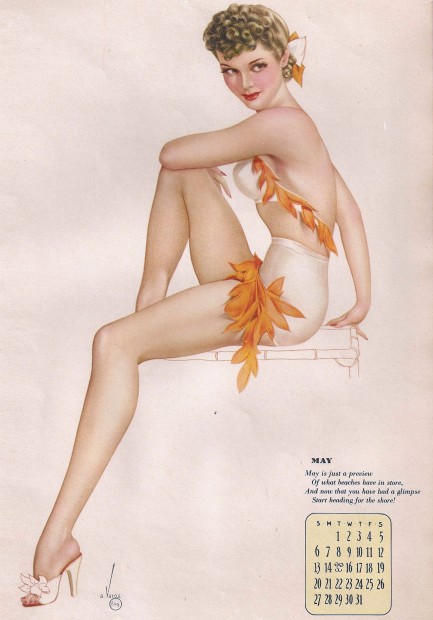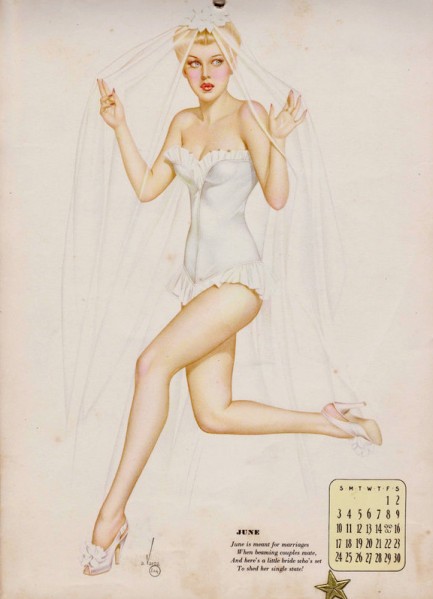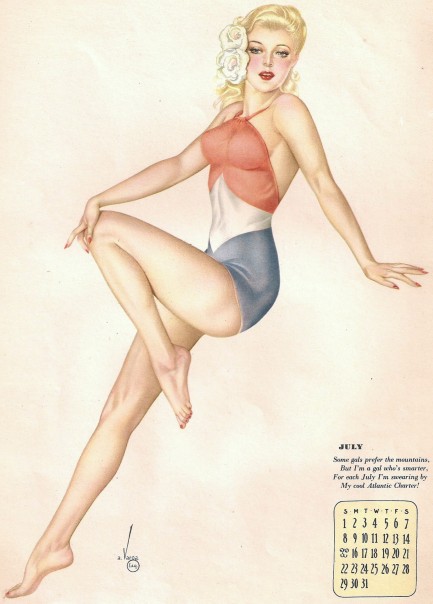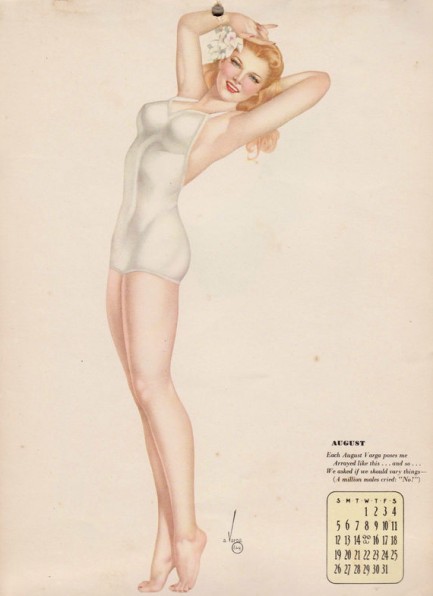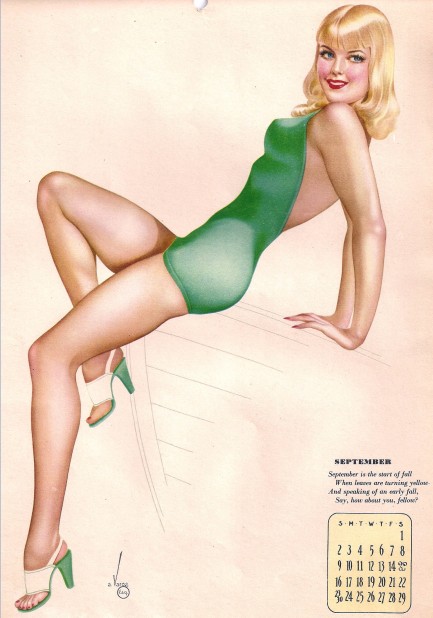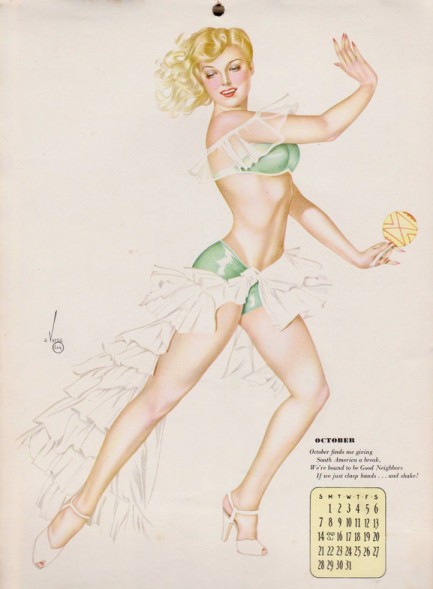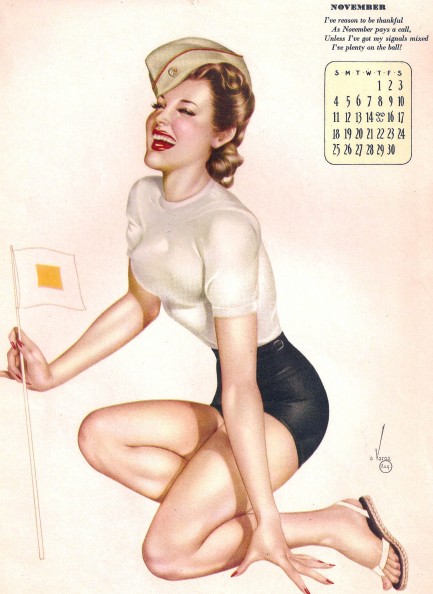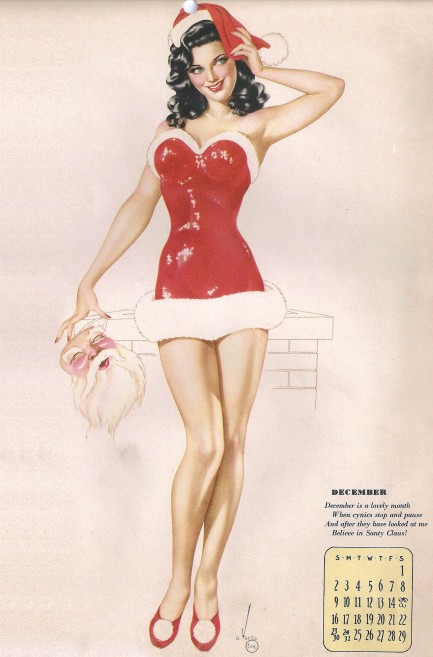 Everything out there wants to kill you—including the people. 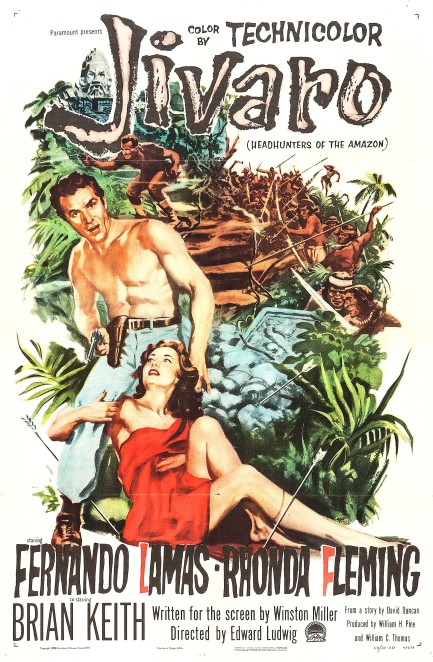
We've shown you many magazines and books on the subject of headhunters (check here and here for our absolute favorites). Mid-century interest in the subject made its way to the silver screen more than once, in this case with Jivaro, which premiered today in 1954. The title references hunter-gatherer cultures centered in the northwestern Amazon rainforest across Ecuador and Peru who shrank human heads for ceremonial reasons. The movie was a 3-D production, a fact that becomes apparent as pottery, chairs, spears, and occasional flaming arrows fly toward the camera, and it was shot in Technicolor. For those reasons, we wouldn't call it a b-movie exactly, but it still could have used a boost in budget.
Fernando Lamas plays a rough and tumble trader who plies the Amazon River in a rat trap boat. This is a rough gig. People are mean as hell down there. Even the local priest knows martial arts. Lamas agrees to conduct hot redhead Rhonda Fleming to meet her fiancée, who has ventured far from the nearest trading post in search of gold. She's fresh from California and has no idea her man has turned into a drunk and is canoodling with a local girl played by Rita Moreno.
Fleming's fiancée goes incommunicado, and eventually Lamas decides to trek into the forbidden Valley of the Winds (cue wind machine and sound effects) in order to find him. There isn't much upside to this quest, but something has developed between Lamas and Fleming, and if they don't know whether her fiancée is dead or alive, he'll always stand between them. Or something like that. They head into the wilds, endure struggles that will look familiar to fans of Raiders of the Lost Ark, and in due time find answers to all their questions, if perfunctorily.
For us, the movie raised new ones, such as where was the screenwriter during all this? Lost in the jungle too, we guess. But we can't say Jivaro is bad. While shot entirely in Hollywood with second unit footage from South America added to fill in the margins, it's actually somewhat convincing in its setting. And Fleming is good, though with her red hair we can't believe the Jivaro we able to miss her with so many arrows. But that's film tradition for you—even today, using better weapons, villains still have terrible aim. If you aim to watch Jivaro, we recommend drinking some firewater to make it a more entertaining diversion, and keeping your expectations in reasonable territory. 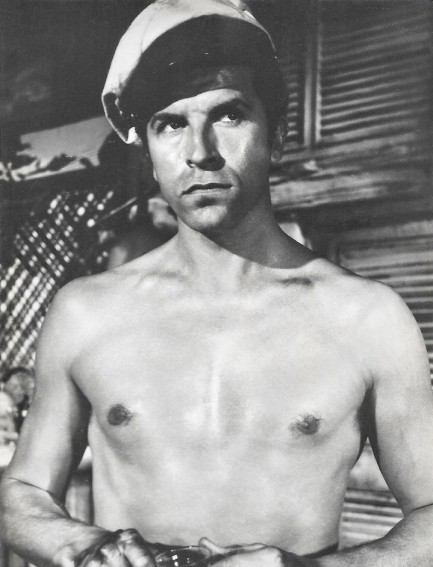 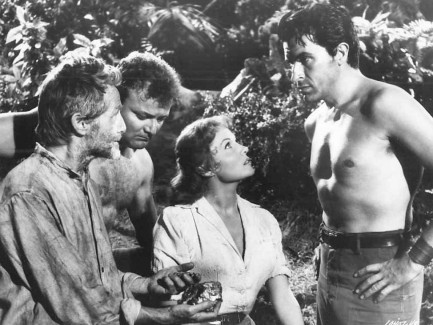 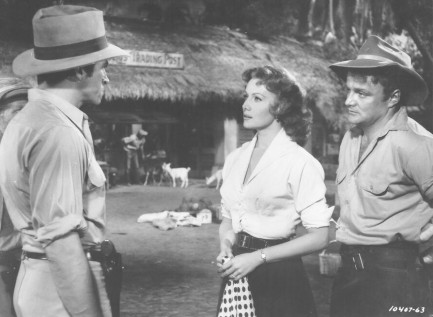 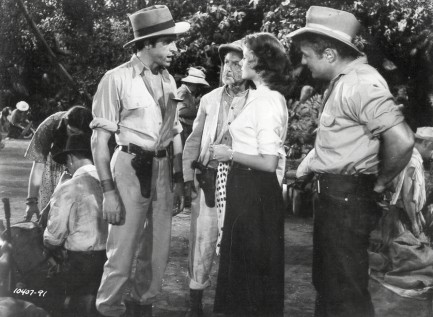 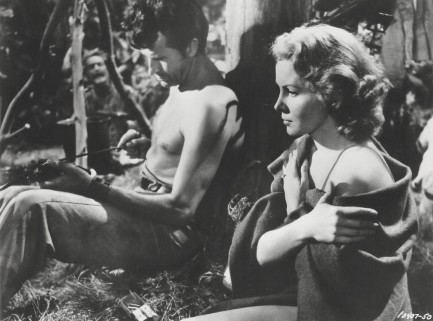 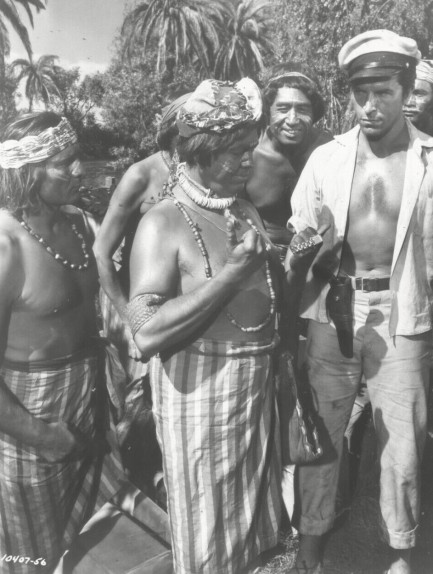 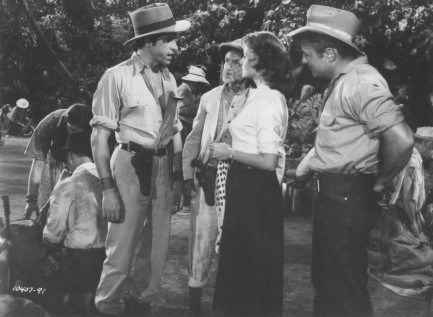 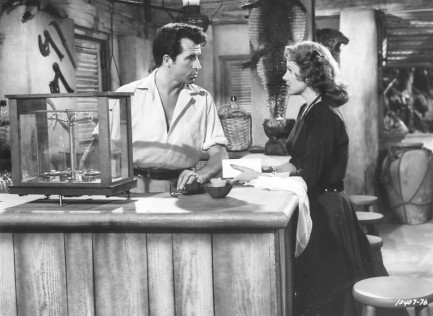 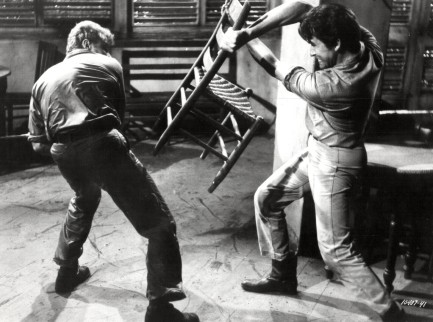 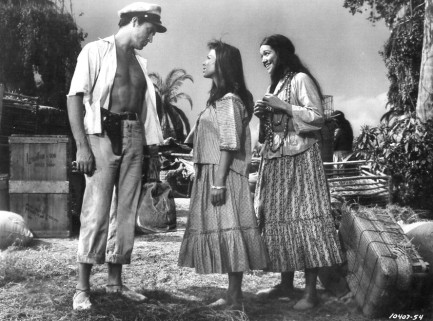 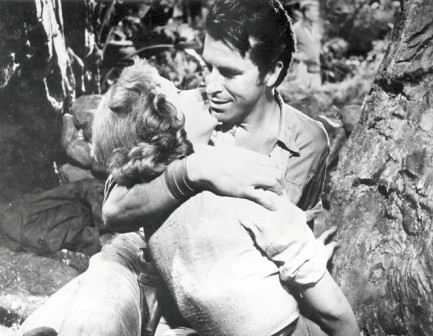 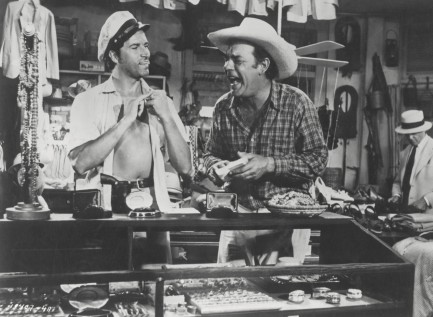 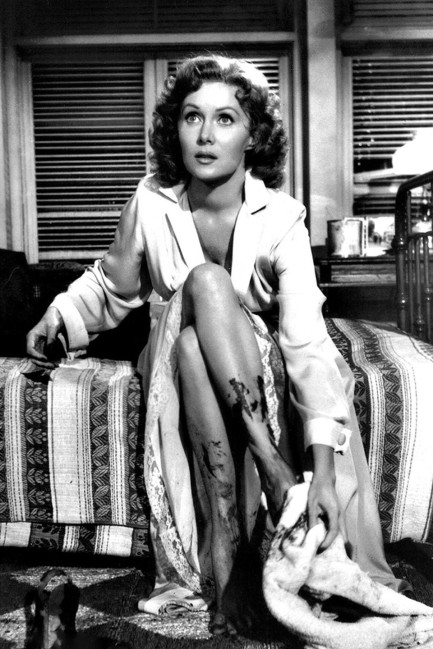 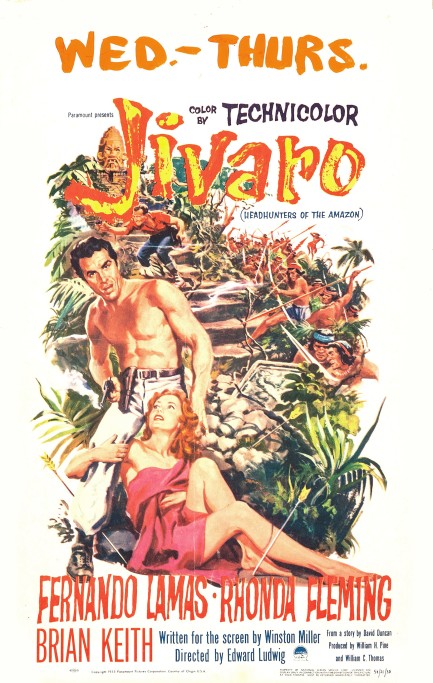
 If it's facts you want you've bought the wrong paper. 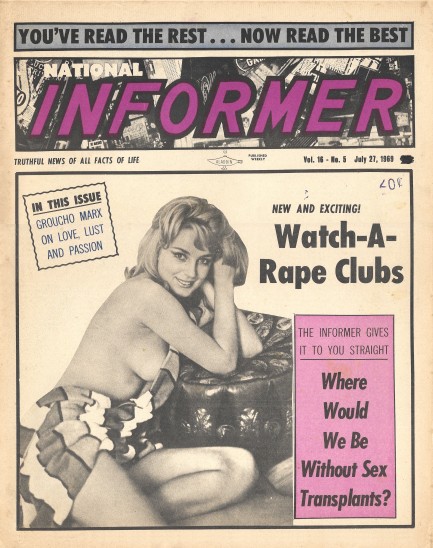
Above is a cover of the tabloid National Informer published today in 1969 with a feature on "watch-a-rape clubs," and we remind you again, these stories are fake. Tabloids at the level of Informer are closer to The Onion than any real newspaper, with the difference being that The Onion is actually funny. While it is absolutely certain that men have stood idly by and watched women be raped (all you have to do is read the news), it's equally certain that there were no watch-a-rape clubs. The story is written as cheesy softcore porn, and the image used is a promotional still from the 1968 movie Les oiseaux vont mourir au Pérou, aka Birds in Peru, with Jean Seberg. It was a controversial film, which is probably why Informer editors borrowed the shot.
They continue their anti-woman campaign in the story, “How To Tell When Someone Feeds You a Pack of Lies.” The pertinent section from author E.W. Steele: “Among the most notorious of liars are fishermen, golfers, salesmen, politicians, and women. The last-named are, perhaps, the most expert of the lot, because they find it so easy to assume an air of maidenly sincerity and absolute innocence. In addition they are less scrupulous than men. Not troubled to the same extent with qualms of conscience, lies flow from their lovely lips like lava.”
Less scrupulous than men? Apparently, this particular Informer is not so much a tabloid, but an encyclopedia of male grievance. They even try to drag Groucho Marx into it, somehow enticing him (if it really is him) into authoring an essay, “Groucho Marx Speaks Out on Love, Lust and Passion.” Marx, globally acknowledged comic genius, doesn't generate many laughs here. But it's late in his career, and maybe the written word simply wasn't his medium. After all, there are no prop eyeglasses and mustache to help him out. While we enjoy major scandal sheets such as Confidential and Whisper, these bottom tier tabloids go against our ethical grain. But we scan and upload them because we consider them useful historical artifacts. Others have agreed. We've been contacted several times over the years and asked to provide full-sized scans for research papers and indie documentaries—though we've never seen the final results of those projects. Hey, you scholars and filmmakers, remember you said you'd send us copies when you were finished? Still waiting.
Elsewhere in Informer the (not so) Great Criswell puts in an appearance. He gives readers his usual set of preposterous psychic predictions. Our fave: I predict that an American writer will win the Nobel Prize for Literature very soon. Criswell probably thought he needed to mix an easy one in there, something he was sure to get correct, and guess what? He was way off! It took seven whole years for an American to win—Saul Bellow in 1976. Does seven years count as very soon? If you're a Galapagos tortoise maybe, but not as far as we're concerned. Back to the drawing board, Criswell.
 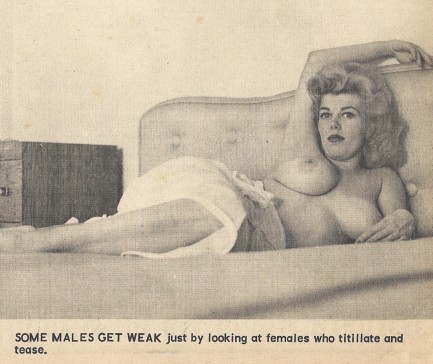 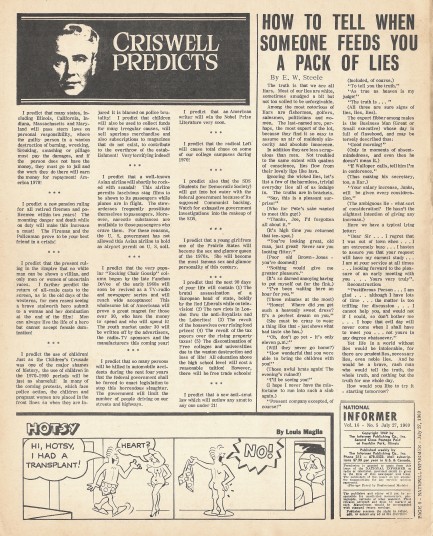 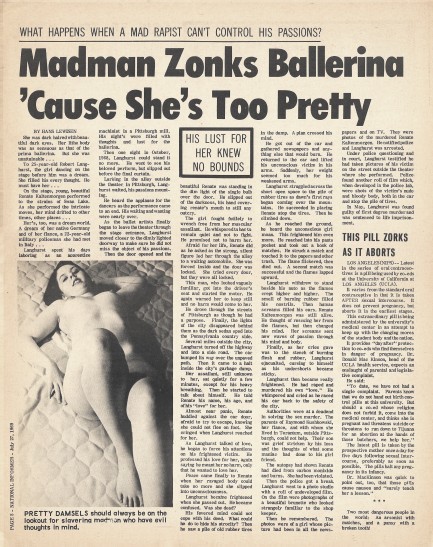 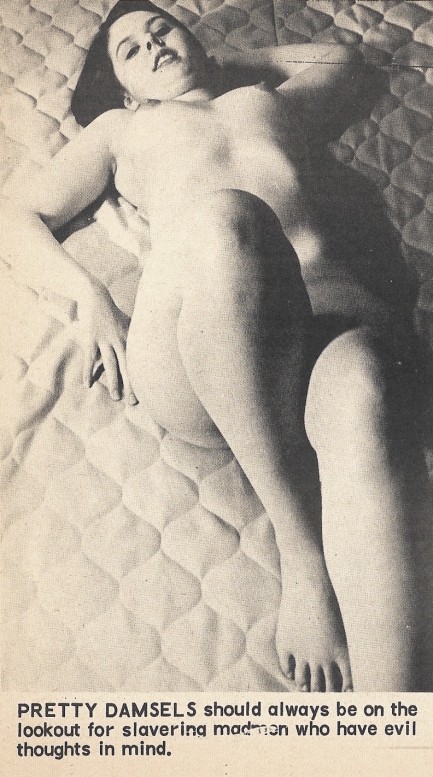 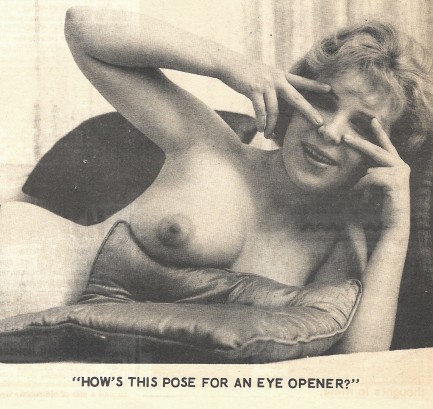 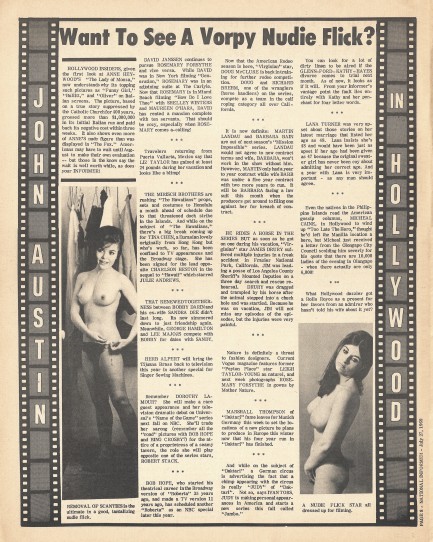 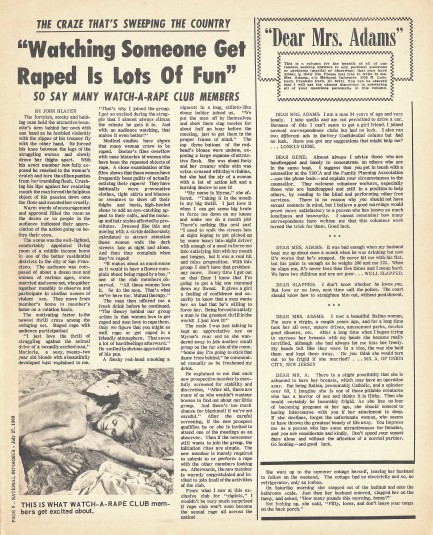 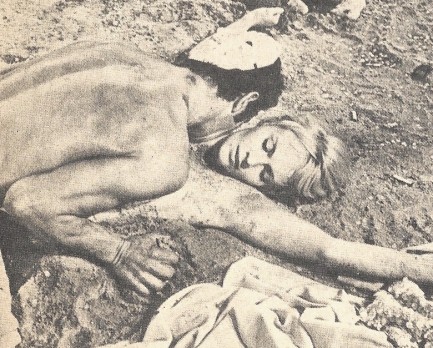 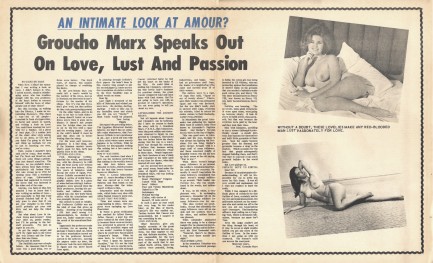  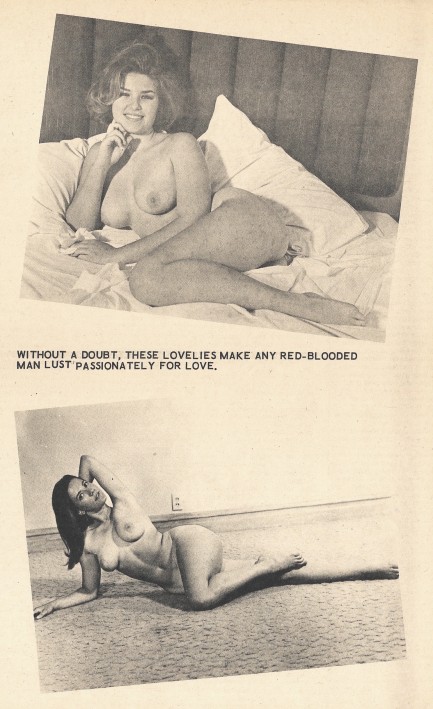 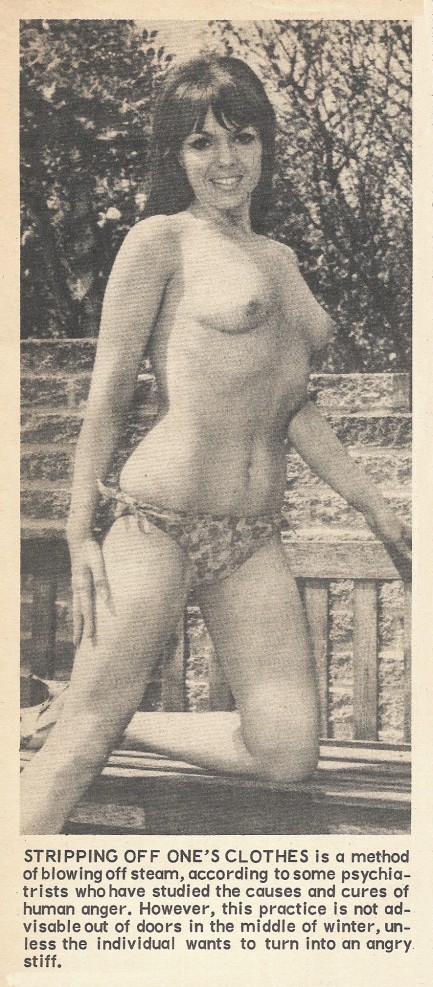
 Gladiatorial combat is all fun and games until the gladiators decide you're the one who needs killing. 
We've featured master fantasy artist Frank Frazetta a few times, so it seems only fair that we feature the yang to his yin, Peruvian born legend Boris Vallejo. Here you see his art on a promo poster for Naked Warriors, which is better known as The Arena, released this month in 1974 starring another legend, Pam Grier, along with occasional co-star, the lovely Margaret Markov. We've talked about the movie twice, shared its Italian and U.S. promo art, and shared rare promo images of Grier once or twice, or maybe even three or four times, as well as a beautiful centerfold of Markov. All of that imagery is worth a look.
Vallejo's art is a nice fit for a tale of enslaved gladiators pitted against each other eventually defying their sadistic masters to fight for freedom. He painted when Corcorde Pictures acquired the rights to the film from MGM/UA for a VHS release in 1988. Concorde/New World was formed and run by schlockmeister Roger Corman, and that explains the black wedges at the top and bottom of the promo. When you do things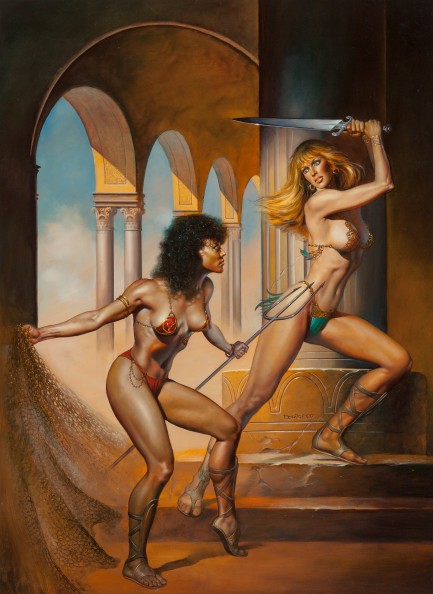 on the cheap as a matter of course like Corman did, tilting the art in an inelegant way to make the two figures fit a door panel format seems logical. We can imagine him: “Just lean the fucker left. Who cares about the blank spots?” And indeed, who does, really? on the cheap as a matter of course like Corman did, tilting the art in an inelegant way to make the two figures fit a door panel format seems logical. We can imagine him: “Just lean the fucker left. Who cares about the blank spots?” And indeed, who does, really?
In addition to a great piece of art, as a bonus we've also uploaded some Arena production photos we found scattered around the internet over the years. Most of them were shot by Italian lensman Angelo Frontoni, whose work we've admired often. As it is a lusty sort of movie, some of the shots are a bit lusty too. We had these sitting about and didn't have a real good excuse to share them until today, so from the good old days of ’70s sexploitation behold: Grier, Markov, Lucretia Love, Maria Pia Conte, Rosalba Neri, and others in barely-there gladiatorial gear—and sometimes less. We can't say the film is perfect, but it's definitely worth a watch. 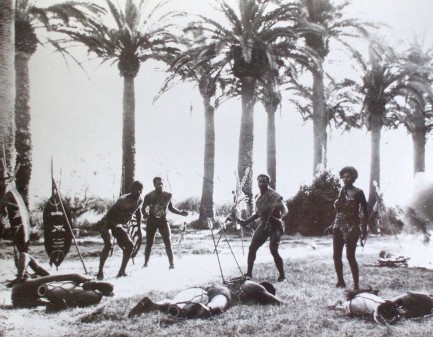 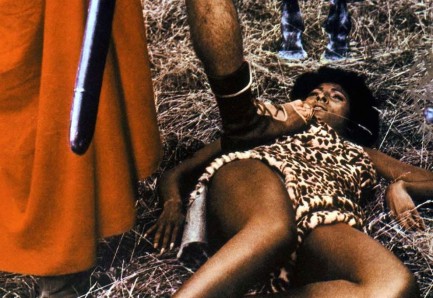 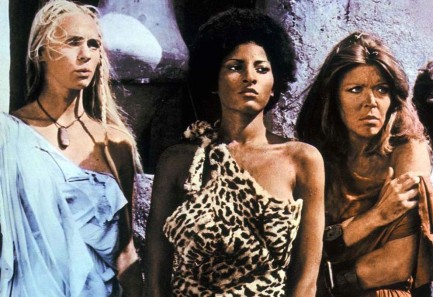 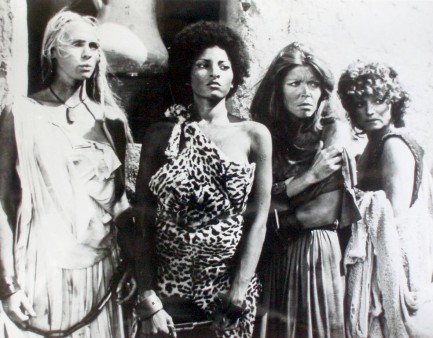 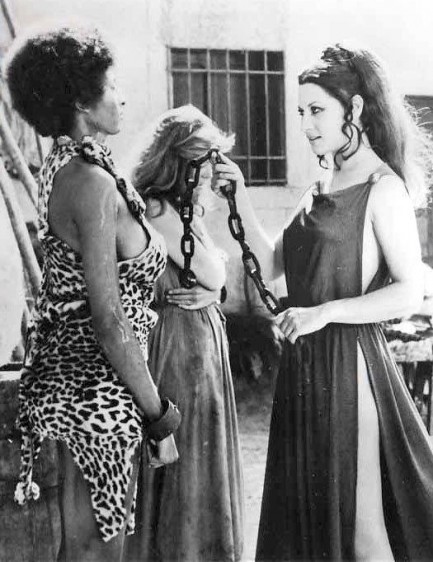 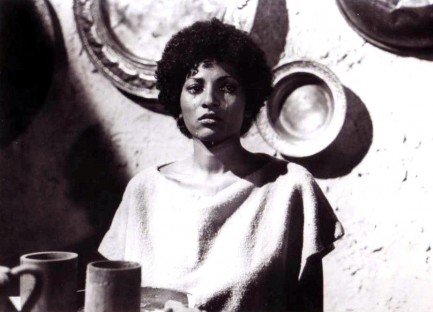 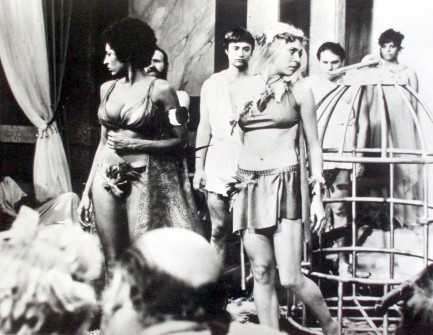 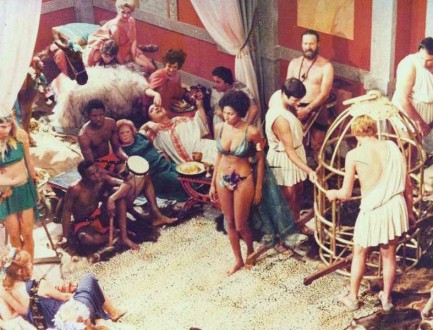 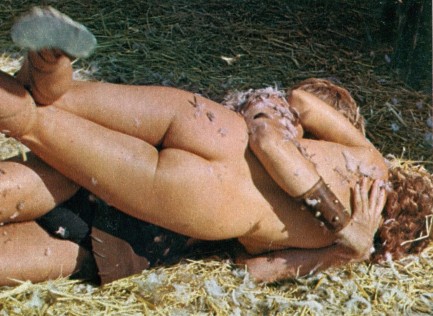 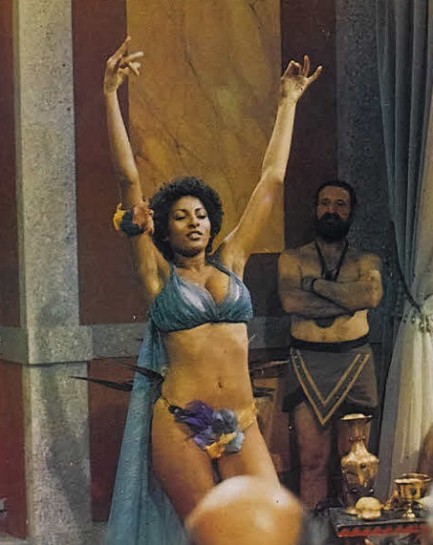 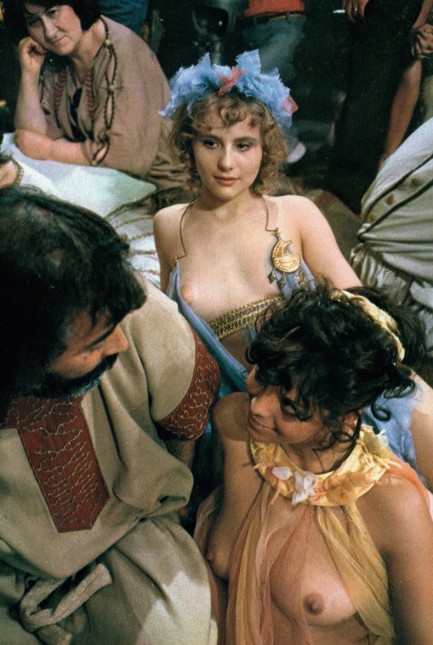 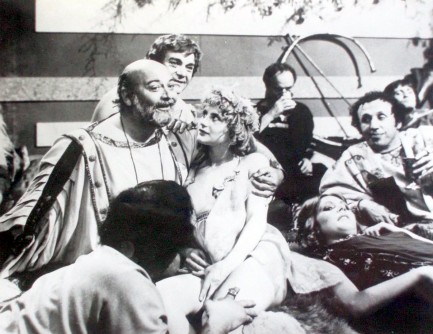 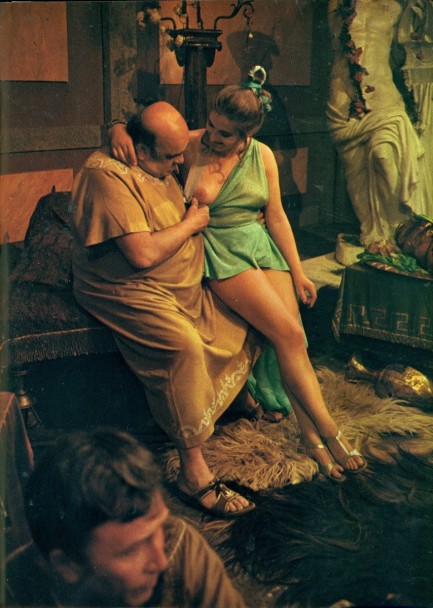 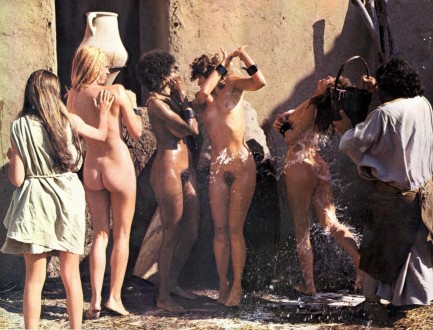 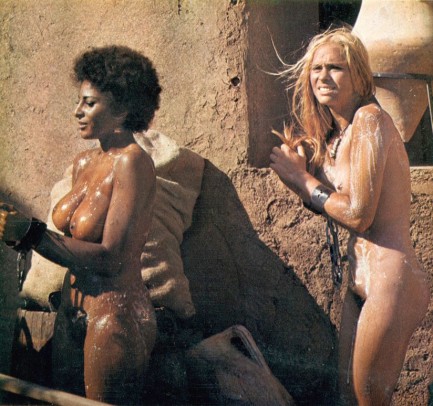 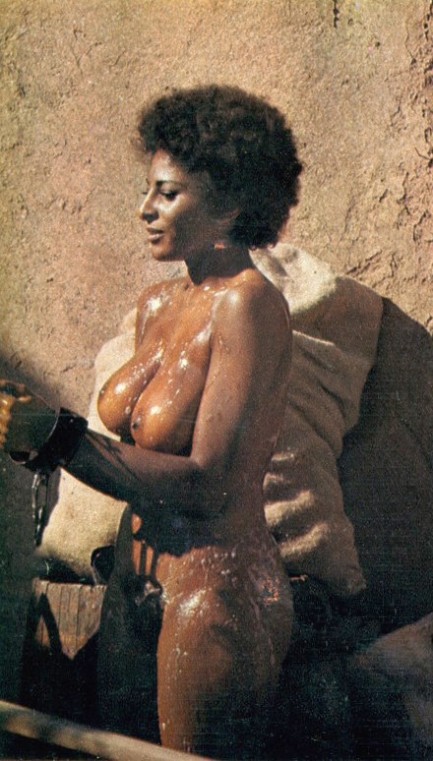 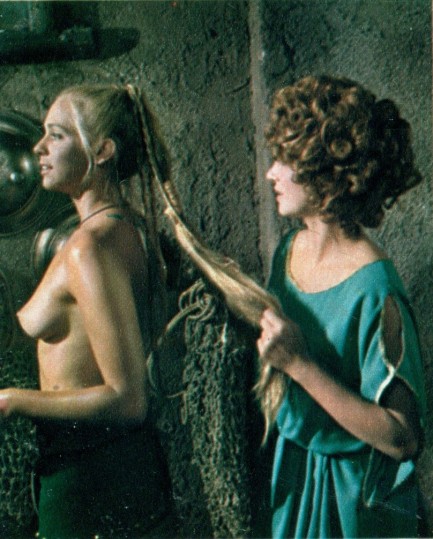 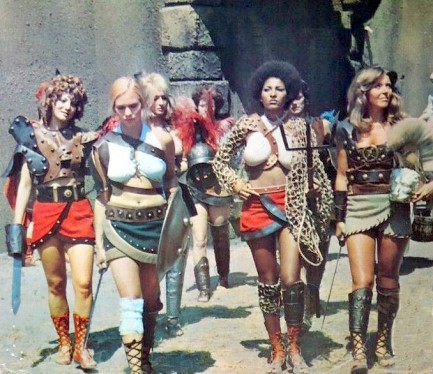  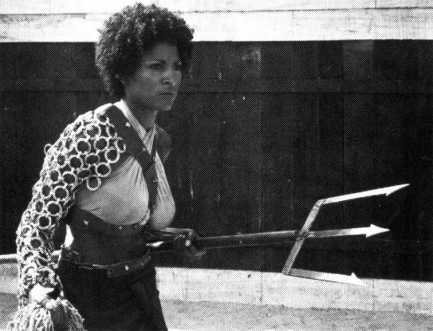 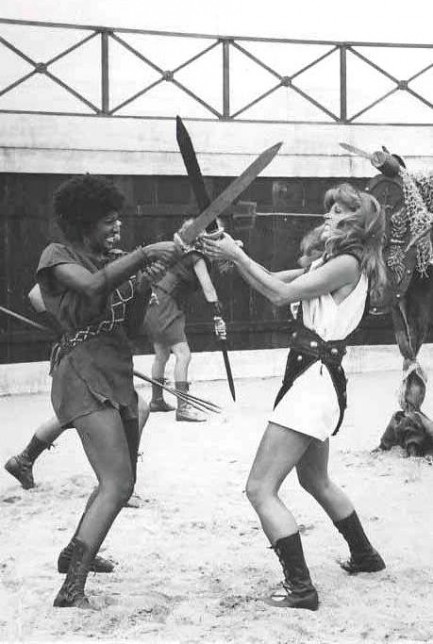 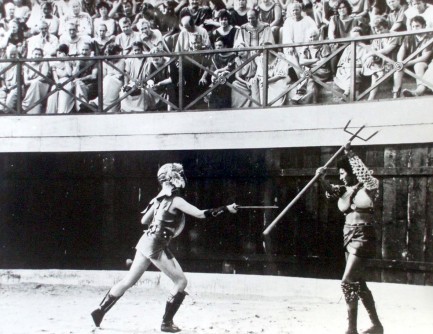 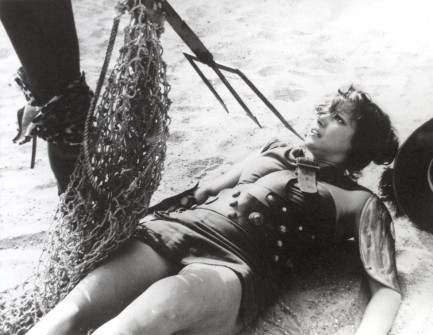 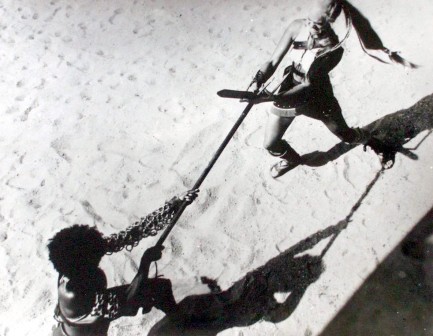 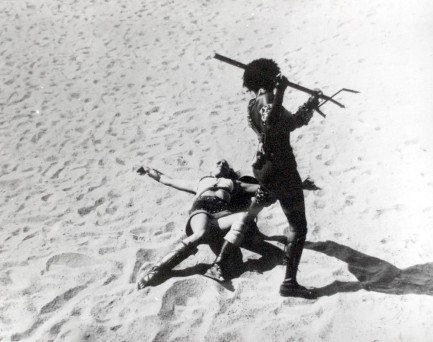 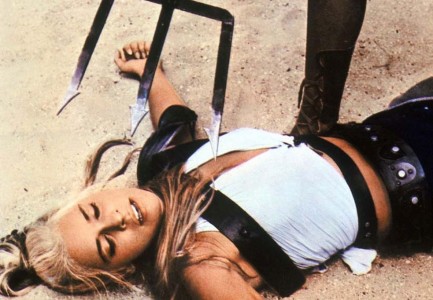 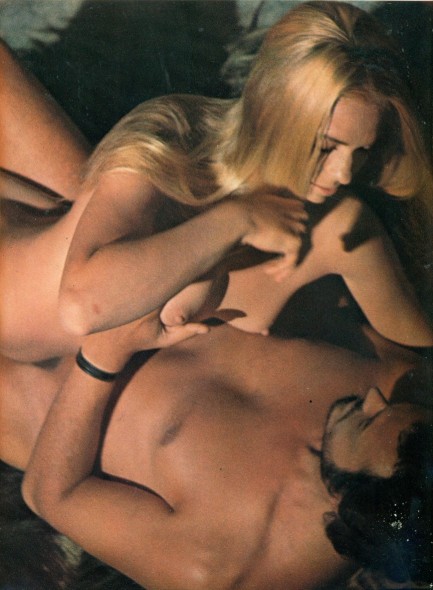
 Huh? What do you mean you tipped him enough earlier to cover our whole stay? 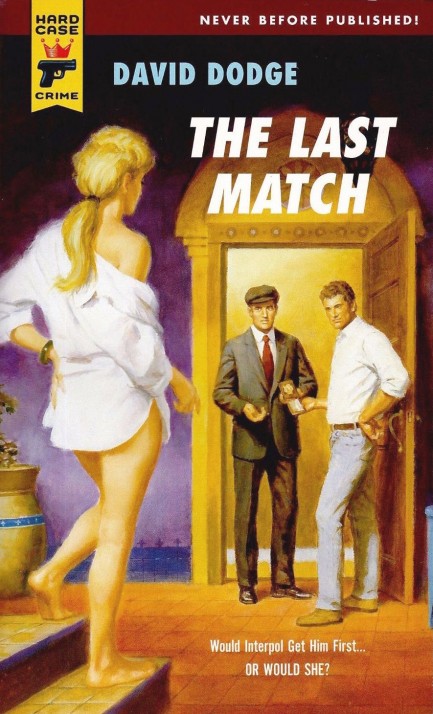 
David Dodge was a very deft writer. When he died in 1974 The Last Match hadn't been published, but Hard Case Crime put it out in 2006, and it falls into the same category as his To Catch a Thief, as well as jet-set grifter novels by other authors. For us this book was tremendously entertaining. Dodge takes his protagonist to Spain, southern France, Tangier, Central America, Brazil, and other exotic locales, weaving in foreign vocabulary and mixing it all up to reflect his character's life as an international rolling stone. Like when he explains offhand that the Brazilian soft drink guaraná is fizzy like a Portuguese vinho verde, but sweet, and perfect for mixing with cachaça. Little things like that give the tale great flavor. And the story of an inveterate con man knocking about from country to country while stalked by a smitten aristocratic beauty (who he refers to as Nemesis) has plenty of amusements. Some say it's not Dodge at his best because it has no plot, but stories only need to entertain. Dodge, like his main character, is remembering the highlights of his life and mixing in a portion of male-oriented fantasy. We'll admit to having a weakness for the tale because we've been to most of the places mentioned, had high times drinking guaraná mixed with cachaça, and met more than one charming hustler or beauty who arrived from parts unknown to send the town reeling. But as objectively as we can manage to assess, we think The Last Match is good, lighthearted fun. Highly recommended.
 Gringo adventurer goes down South American rabbit hole looking for Inca treasure. 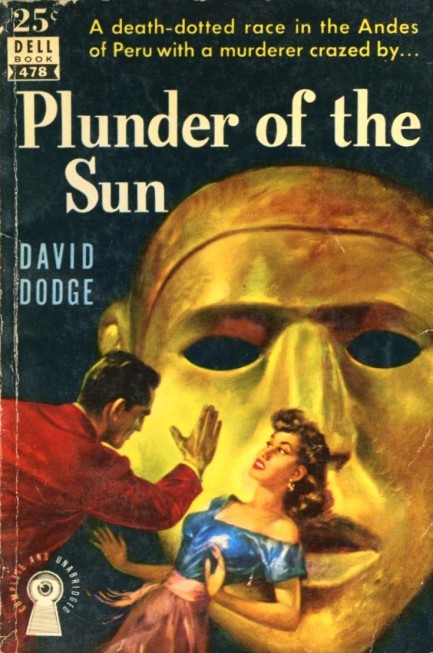
Pulp fiction, genre fiction, crime fiction—call it what you want. Basically, none of it will ever win a Pulitzer Prize, but it can be mighty enjoyable when done just right. Plunder of the Sun is faster than fast pulp-style fiction from To Catch a Thief author David Dodge. The rough and tumble protagonist Al Colby tries to unravel the secret of an Inca quipa—an ancient numero-linguistic recording device—which may tell the location of an impossibly huge hoard of gold. The tale speeds from Santiago, Chile to Lima, Peru and into the high Andes by boat, train, and tram to a climax on the highest lake in the world.
This is a confident yarn from an author who traveled widely in the countries portrayed, and his tale avoids the cultural judgments you often find in these types of novels. His descriptions of cities, hotels, and transport are unflattering but accurate, yet his treatment of the Peruvian and Chilean villains has no whiff of condescension. They're just the villains, nothing more—smart, tough, deadly, and motivated. The book's only flaw is its late turn toward romantic matchmaking. Still, it was a very good read. It became a movie of the same name in 1953, placed in a new setting, with Glenn Ford and Diana Lynn. The art on this 1951 Dell paperback is by Robert Stanley, and as a bonus it comes in a collectible mapback edition. 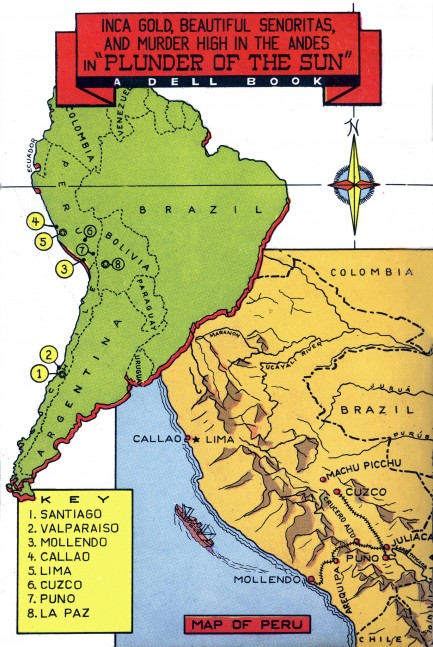
 Trevor makes the most of her smoke break by posing for a master. 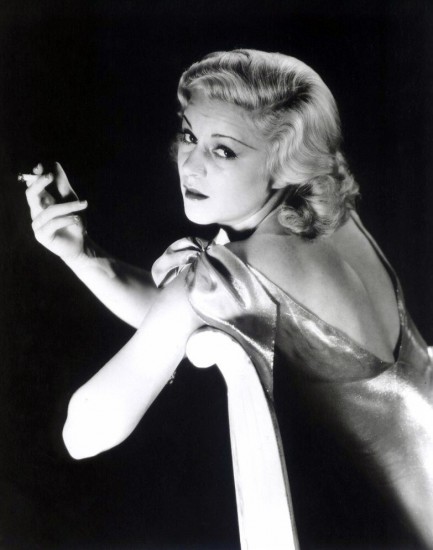
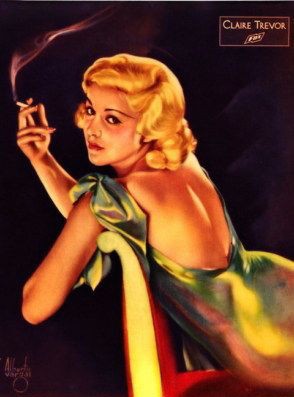 Brooklyn born actress Claire Trevor made more than sixty movies over seven decades, including the important film noir entries Raw Deal, Born To Kill, Johnny Angel, Murder My Sweet, and Key Largo, the latter of which snared her an Academy Award for Best Supporting Actress. Brooklyn born actress Claire Trevor made more than sixty movies over seven decades, including the important film noir entries Raw Deal, Born To Kill, Johnny Angel, Murder My Sweet, and Key Largo, the latter of which snared her an Academy Award for Best Supporting Actress.
She's good in general, but if you haven't seen her in Key Largo you really should. She's absolutely brilliant in it. She was one of film noir's defining artists, an indispensable participant in it. We're also fond of her in lighter fare such as 1965's How To Murder Your Wife, with Jack Lemmon. The noirish shot above was used as a reference photo by the legendary Peruvian artist Alberto Vargas. He painted a portrait of Trevor which you see inset just above, and you also see her posing with the piece below. The portrait was commissioned by her employers Fox Film Corporation as a promo image, a type of work Vargas did often, and the studio used prints of portrait as lobby cards. All of these images came about in 1934.
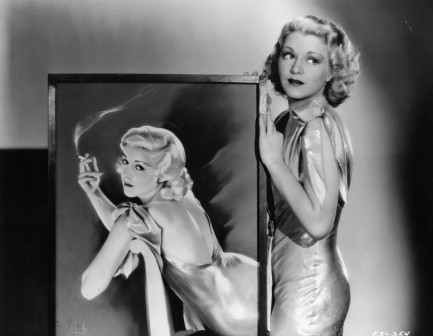
 From Hollywood brawls to wet celebs Lowdown gives readers their money’s worth. 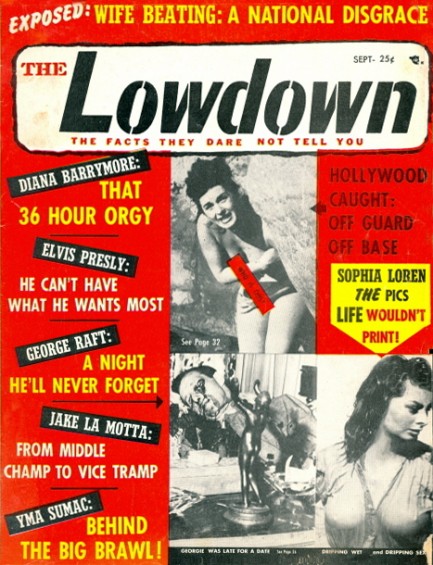
This issue of The Lowdown from September 1957 has three stories of particular note, we think. First, readers learn about Diana Barrymore’s fast, out-of-control life, which she had shared with the world earlier that year in an autobiography entitled Too Much, Too Soon. She had just gotten out of a long stint in rehab, and the book was a sort of catharsis, as well as an attempt to let the show business world know that she was cleaned up and ready to work again. But the revelations in the book were of a sort that had never before been encountered by the American public in an autobiography, and the controversy never really faded. Even Mike Wallace asked Barrymore in a televised interview if, like the title of her book, it all wasn’t a bit much. Three years later, at age 38, Barrymore died from an oh-so-familiar lethal Hollywood combo of booze and sleeping pills. 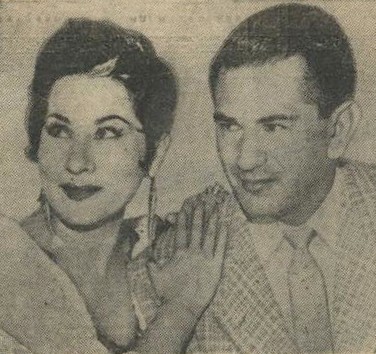 Readers are also told about a brawl at the house of Peruvian singer Yma Sumac. She had just filed from divorce from her husband Moisés Vivanco and had gone by to pick up a few items. In no time at all, she, singers Esmila Zevallos and Benigno Farfan, and private detective Fred Otash got into a hair-pulling scuffle, with the family dog at the center, to boot. Even the L.A. Times covered the fight. It seemed no couple could be more in need of a permanent split than Vivanco and Sumac, but the divorce didn’t take—they remarried later the same year. Readers are also told about a brawl at the house of Peruvian singer Yma Sumac. She had just filed from divorce from her husband Moisés Vivanco and had gone by to pick up a few items. In no time at all, she, singers Esmila Zevallos and Benigno Farfan, and private detective Fred Otash got into a hair-pulling scuffle, with the family dog at the center, to boot. Even the L.A. Times covered the fight. It seemed no couple could be more in need of a permanent split than Vivanco and Sumac, but the divorce didn’t take—they remarried later the same year.
And finally Lowdown takes Life magazine to task for not having the guts to publish racy photos of Sophia Loren from her 1957 romance Boy on a Dolphin, about a woman in the Greek Isles who while diving for sponges discovers a potentially valuable, ancient gold statue of a boy on a dolphin. We’re talking Sophia Loren in wet clothes. And really, that brings us to the entire reason we’re featuring Lowdown today—so we have an excuse to publish one of the photos in question. There it is below, and now your Friday has gotten that much brighter, right? More from Lowdown soon.
Update: a great color photo from the film just showed up online. We've added that at bottom.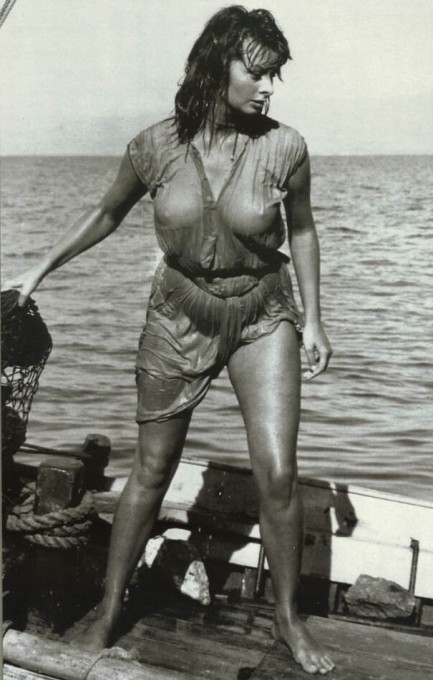 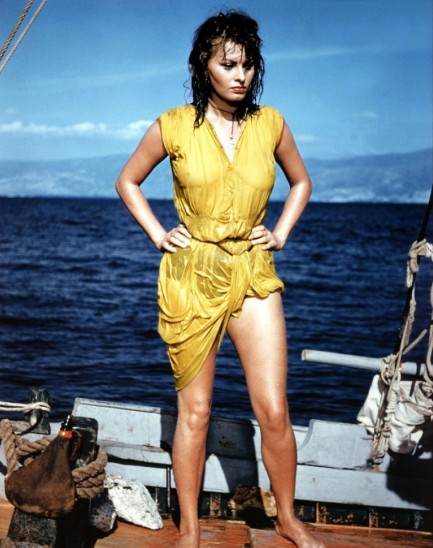
 Murder and mutilation at the top of the world. 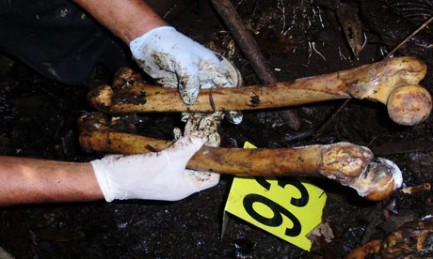
Police in Peru have arrested members of a gang that allegedly killed peasants in order to remove the fat from their bodies and sell it abroad in anti-wrinkle cream. Three suspects under arrest have already admitted to five killings, but Peruvian police think the macabre practice may date back for decades. At a press conference yesterday, authorities displayed two bottles of the fat, which forensic tests had confirmed were of human composition. Police described how gang members killed victims, beheaded them and hollowed out their bodies, then suspended them over candles while the heat liquefied the fat. The announcement was met with some skepticism abroad, however in a world where people pay small fortunes for esoterica such as powdered tiger penises and monkey gall bladders, the possibility of a black market in human fat—and the $60,000 per gallon price tag gang members claim the substance fetched—cannot be easily discounted. The region where the gang operated, a remote area in the high Andes known as Huanuco, has had sixty people go missing this year alone. And while Huanuco is also frequented by Shining Path drug traffickers, the gang members were able to lead police directly to a site where a fat extraction had taken place (above). For now, Peruvian authorities have begun to shift their efforts toward finding out who might be buying the fat, and in which countries it might be distributed and sold. Meanwhile, other members of the gang, including the alleged leader, remain at large.
|
 |

The headlines that mattered yesteryear.
2003—Hope Dies
Film legend Bob Hope dies of pneumonia two months after celebrating his 100th birthday. 1945—Churchill Given the Sack
In spite of admiring Winston Churchill as a great wartime leader, Britons elect
Clement Attlee the nation's new prime minister in a sweeping victory for the Labour Party over the Conservatives. 1952—Evita Peron Dies
Eva Duarte de Peron, aka Evita, wife of the president of the Argentine Republic, dies from cancer at age 33. Evita had brought the working classes into a position of political power never witnessed before, but was hated by the nation's powerful military class. She is lain to rest in Milan, Italy in a secret grave under a nun's name, but is eventually returned to Argentina for reburial beside her husband in 1974. 1943—Mussolini Calls It Quits
Italian dictator Benito Mussolini steps down as head of the armed forces and the government. It soon becomes clear that Il Duce did not relinquish power voluntarily, but was forced to resign after former Fascist colleagues turned against him. He is later installed by Germany as leader of the Italian Social Republic in the north of the country, but is killed by partisans in 1945.
|

|
|

It's easy. We have an uploader that makes it a snap. Use it to submit your art, text, header, and subhead. Your post can be funny, serious, or anything in between, as long as it's vintage pulp. You'll get a byline and experience the fleeting pride of free authorship. We'll edit your post for typos, but the rest is up to you. Click here to give us your best shot.

|
|

































 on the cheap as a matter of course like Corman did, tilting the art in an inelegant way to make the two figures fit a door panel format seems logical. We can imagine him: “Just lean the fucker left. Who cares about the blank spots?” And indeed, who does, really?
on the cheap as a matter of course like Corman did, tilting the art in an inelegant way to make the two figures fit a door panel format seems logical. We can imagine him: “Just lean the fucker left. Who cares about the blank spots?” And indeed, who does, really?


































 Brooklyn born actress Claire Trevor made more than sixty movies over seven decades, including the important film noir entries Raw Deal, Born To Kill, Johnny Angel, Murder My Sweet, and Key Largo, the latter of which snared her an Academy Award for Best Supporting Actress.
Brooklyn born actress Claire Trevor made more than sixty movies over seven decades, including the important film noir entries Raw Deal, Born To Kill, Johnny Angel, Murder My Sweet, and Key Largo, the latter of which snared her an Academy Award for Best Supporting Actress.

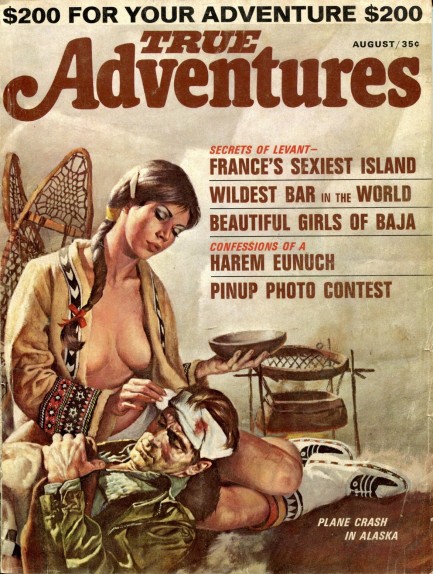
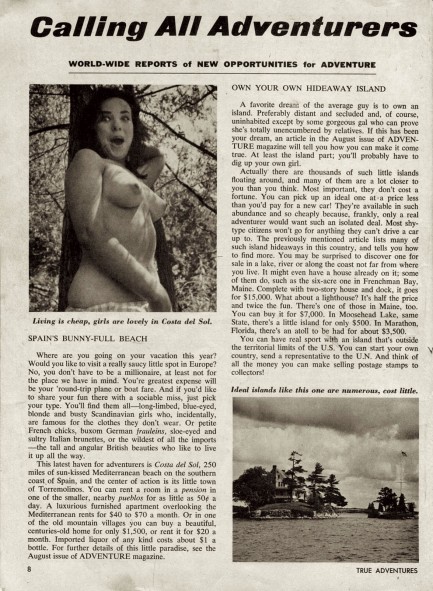

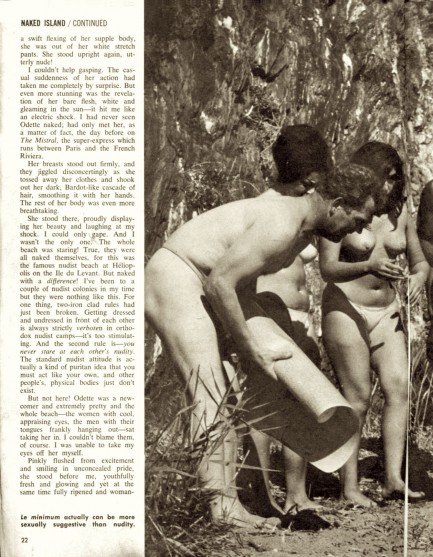
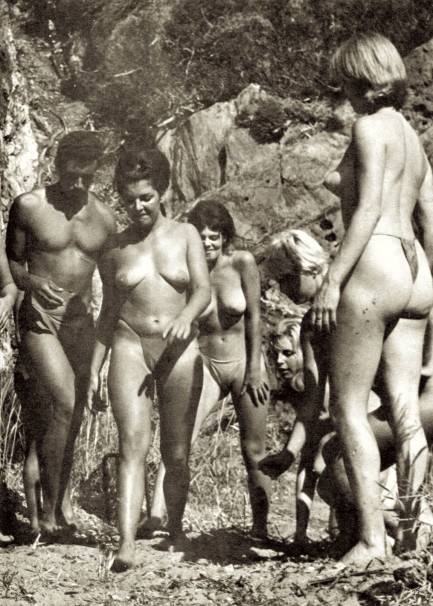
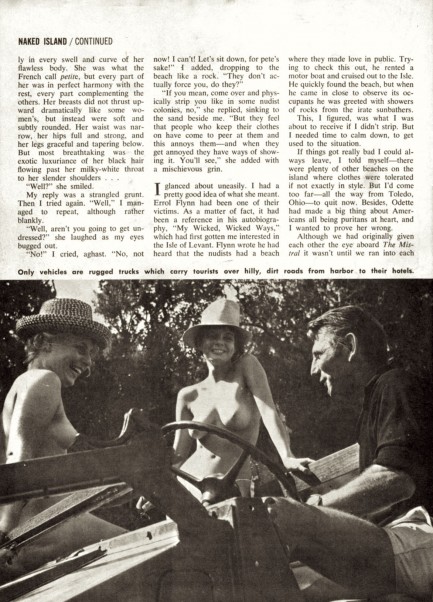
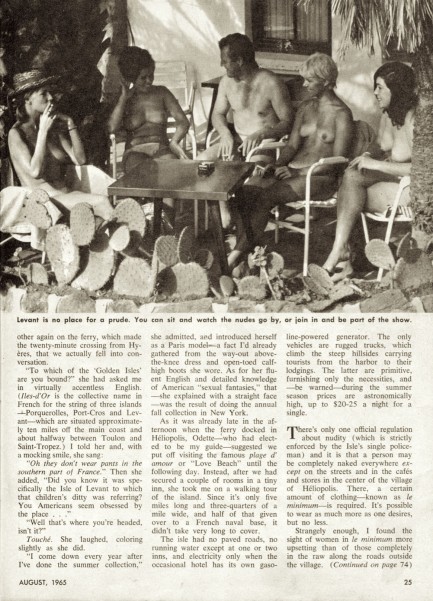
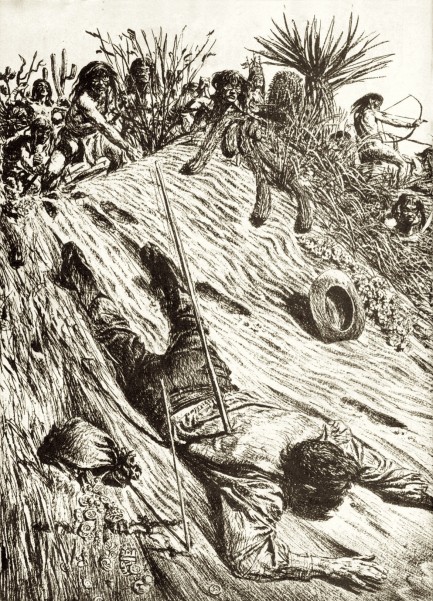

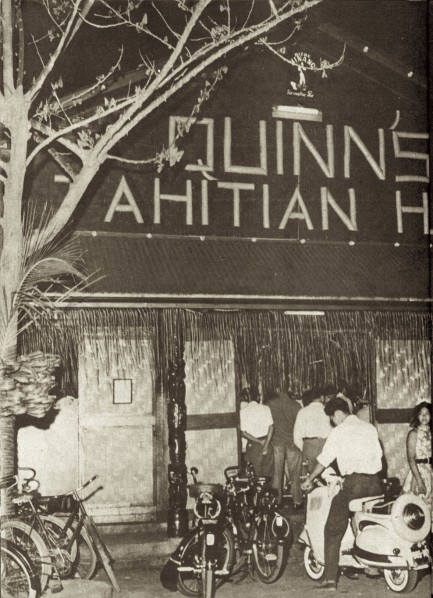
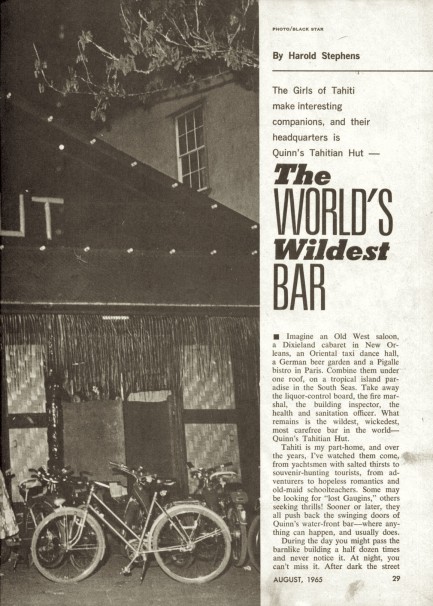
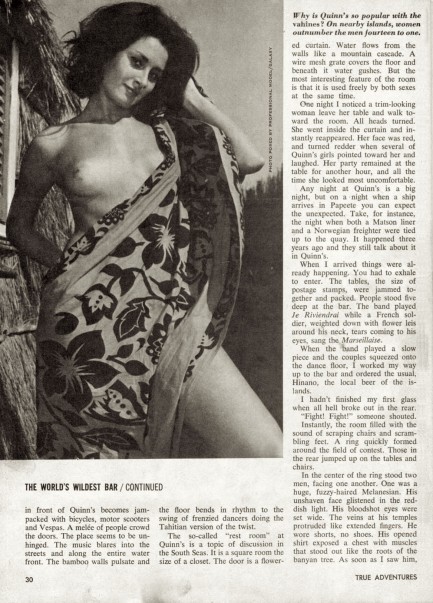
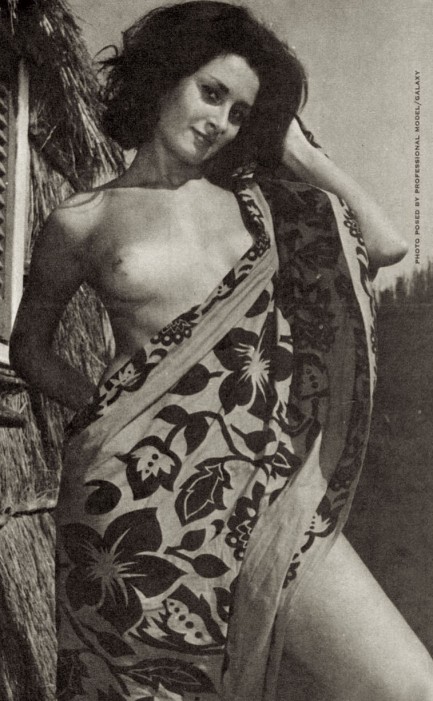
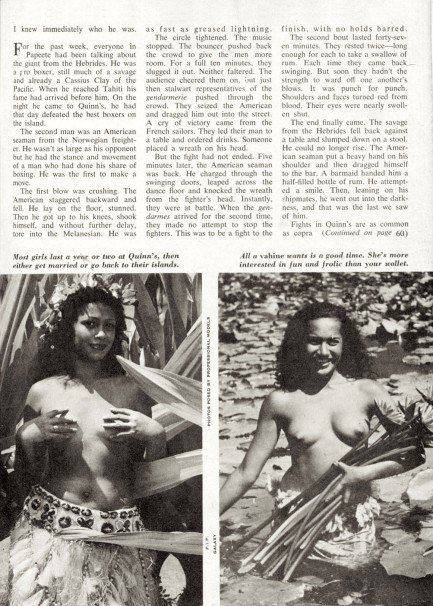
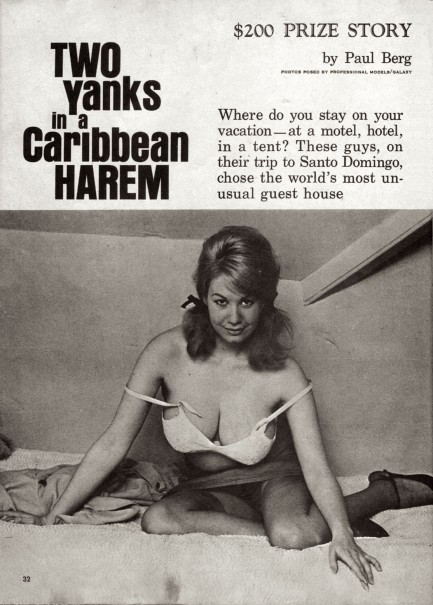
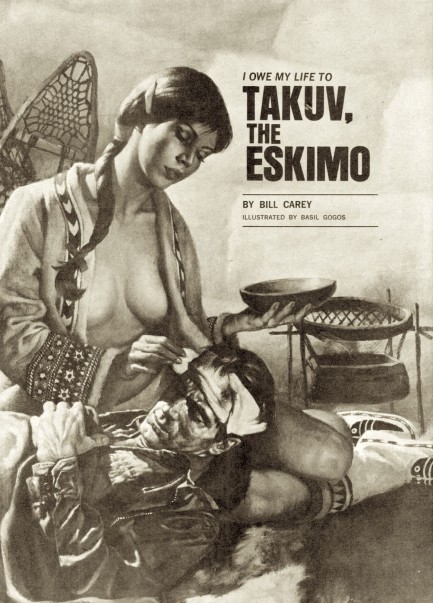
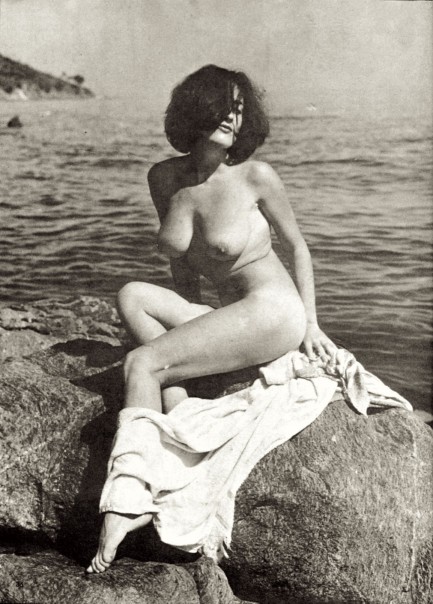
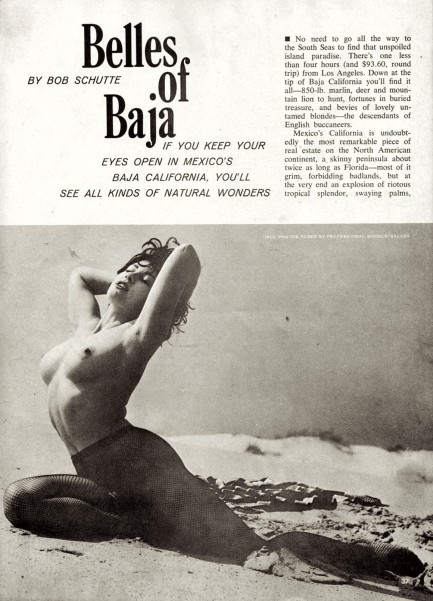

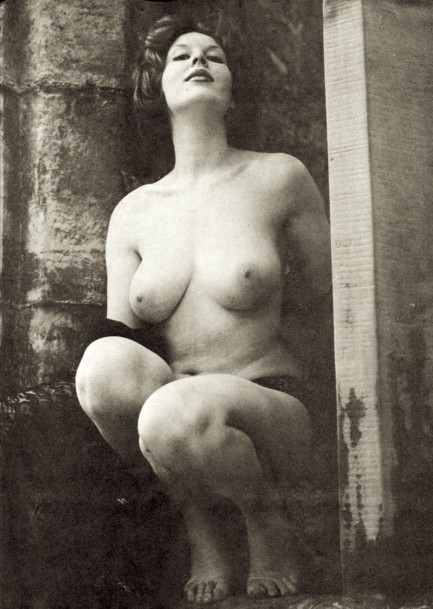
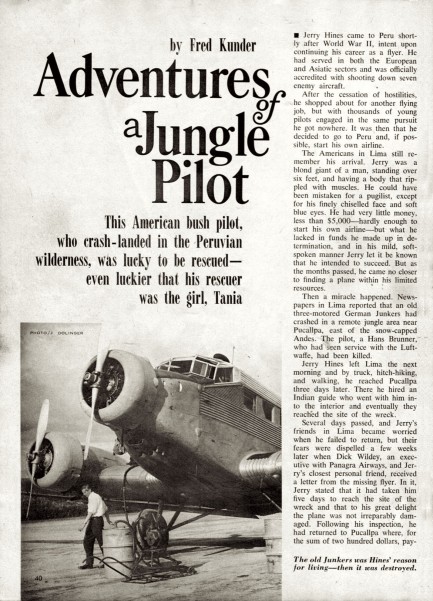
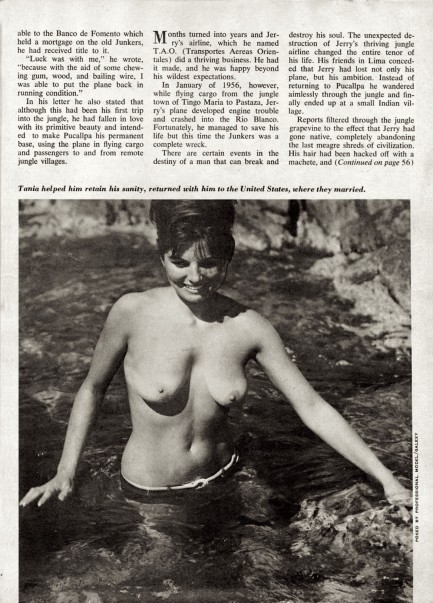
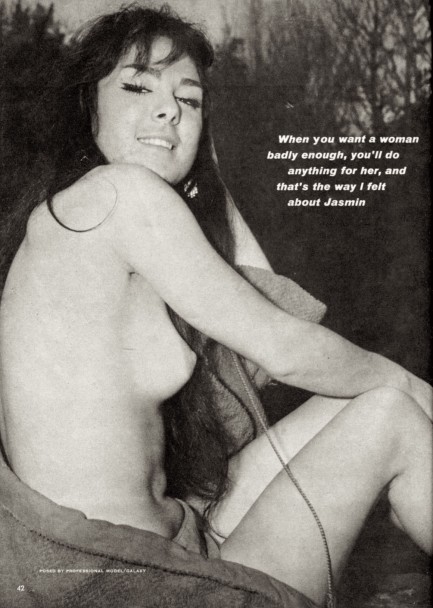
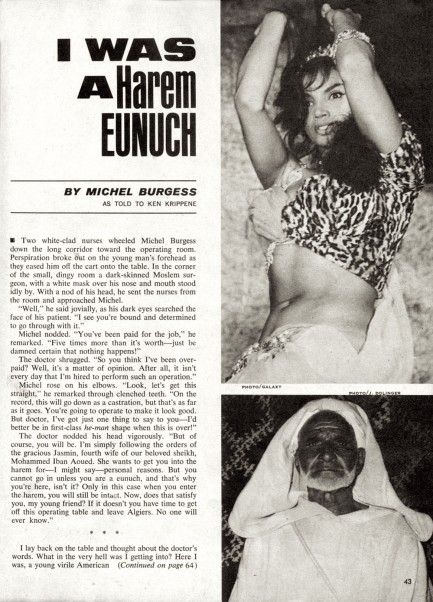
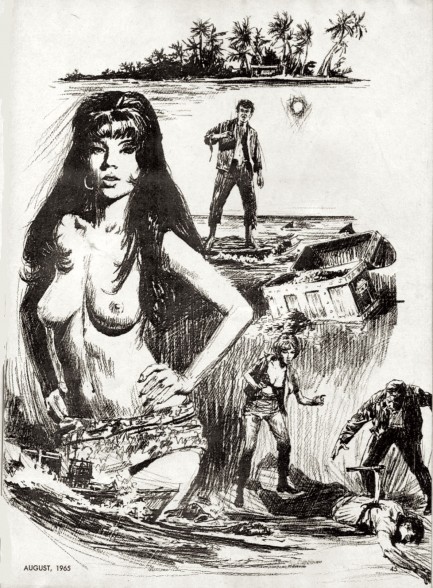
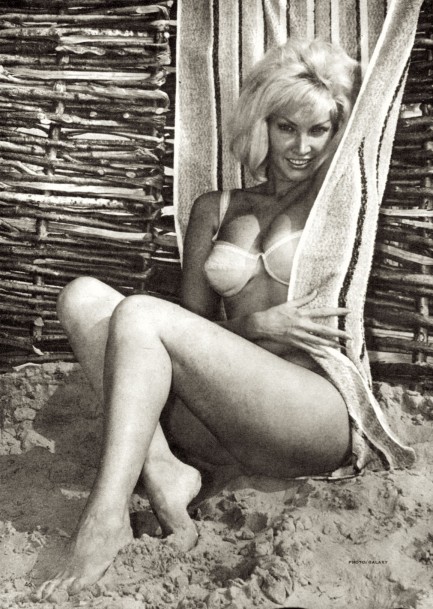
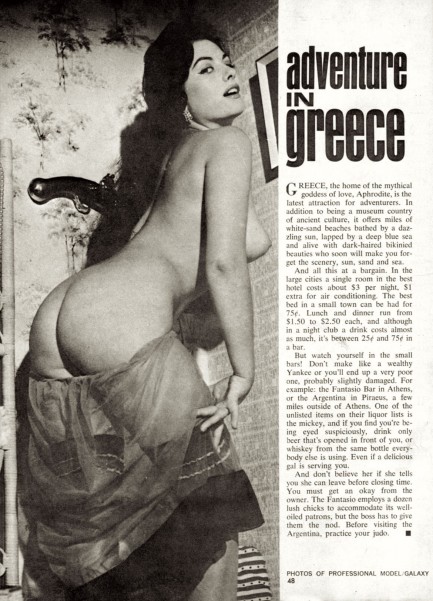

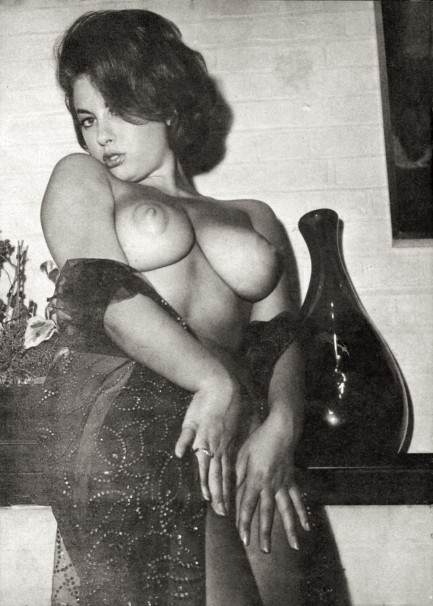
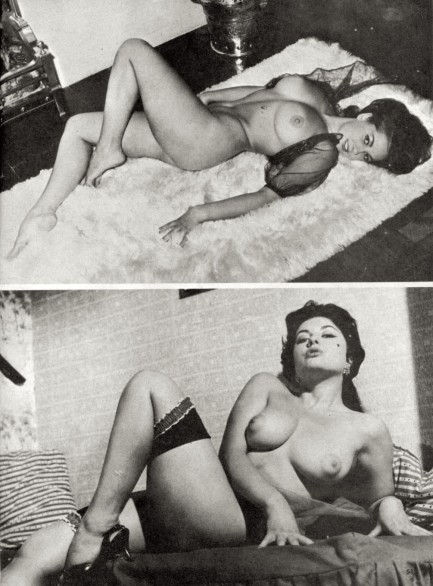
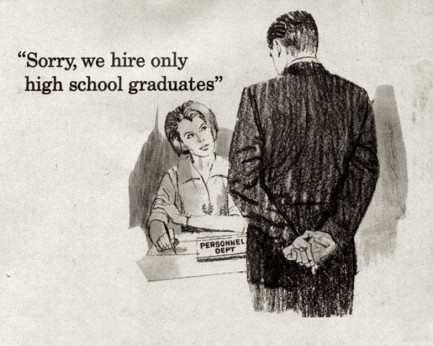


 Readers are also told about a brawl at the house of Peruvian singer Yma Sumac. She had just filed from divorce from her husband Moisés Vivanco and had gone by to pick up a few items. In no time at all, she, singers Esmila Zevallos and Benigno Farfan, and private detective Fred Otash got into a hair-pulling scuffle, with the family dog at the center, to boot. Even the L.A. Times covered the fight. It seemed no couple could be more in need of a permanent split than Vivanco and Sumac, but the divorce didn’t take—they remarried later the same year.
Readers are also told about a brawl at the house of Peruvian singer Yma Sumac. She had just filed from divorce from her husband Moisés Vivanco and had gone by to pick up a few items. In no time at all, she, singers Esmila Zevallos and Benigno Farfan, and private detective Fred Otash got into a hair-pulling scuffle, with the family dog at the center, to boot. Even the L.A. Times covered the fight. It seemed no couple could be more in need of a permanent split than Vivanco and Sumac, but the divorce didn’t take—they remarried later the same year.


